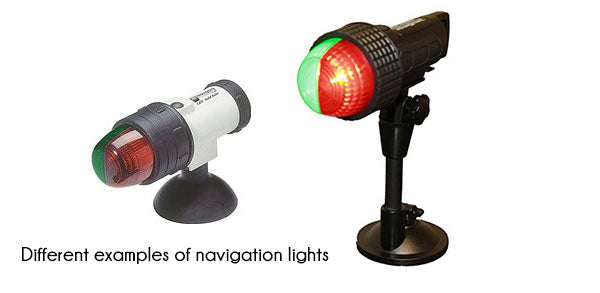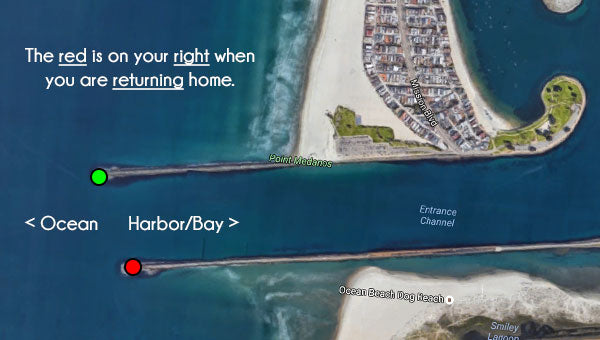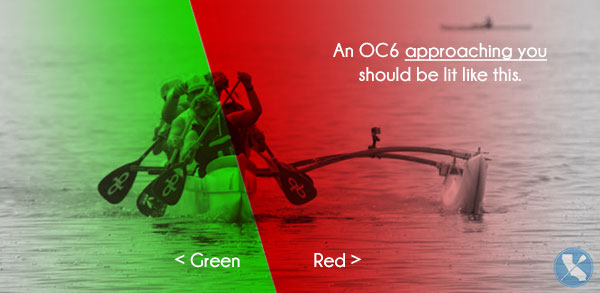It is that time of year...the sun is going down earlier, and our daylight hours are more limited. While it makes for colder paddles, though, we still get out on the water! That said, it is sometimes in the dark. And with that comes added safety concerns. Fortunately there are safety lights for our craft and coast guard regulations to help keep us safe. But what lights are best to paddle with? And what is required? And most baffling....which side should have the red and which the green? Allow me the chance to help clarify all of this.

What lights are required when I paddle at night?
Craft under 40' - (SUP, Prone, Surfski, Kayak, OC1,OC2, DB1) Most of us paddlers are considered small craft if under 40', and do not have the same requirements of bigger boats. We are also under the same requirements as rowing or under sail craft since our propulsion is not powered. We are required to have illumination on us for safety at night. However, instead of having the red and green navigation lights (more on those below) we can be in compliance with a white all-around light. By all-around it should be visible from all directions, (360 degrees). Waterproof lights like these can be found on Amazon or West Marine with suction cup mounts that will stick them to your canoe, ski or paddleboard. (Tip: attaching a lightweight leash rope or string tether to it and to your board will make sure if the suction falls off, you don't lost your light into the depths below.)

Click to shop for these lights
You will note that in the last paragraph I said most of us paddlers. For those who paddle Dragon Boat or 6-Man Outrigger Canoes, we generally equal or exceed that 40' length. In fact many paddlers and clubs insist on having more robust lighting than the minimum requirement and we encourage such safety efforts. So in those situations what is needed?
40' and over - Navigation Lights (separate or combination) are required in the front for these water craft as well as a White Stern (rear) Light. Navigation lights are red and green and to be placed at the front of your craft. The white light is to be placed towards the back. Bigger sail or powered boats usually have separate green and red lights for either side. But for us paddlers that is a lot more to worry about carrying and turning on. So they created combination lights for us which have the red and green on one illuminated device. Hooray! But wait! How do we orient them?

Click here to shop for these lights
Which direction should the red and green light face?
This is perhaps the most important part of this article. If not only for safety but to make sure you don't lose a beer bet with your teammates or look foolish to some salty waterman in your crew. Let me just say this right away.
- The red light should be on the paddler's left (port) as they paddle and face forward.
- The green light should be on the paddlers right (starboard) as they paddle and face forward.

| Shorter words | Longer words |
| Left | Right |
| Port | Starboard |
| Red | Green |
But what is the saying Red Right Return(ing) all about?
Perhaps you always heard about "red right return" or "red right returning" and are confused. Above I just told you "red is left"...(whimper)! Have no fear I will explain. You see this phrase is used in reference to aids to navigation such as channel markers, harbor entrances or other structure areas. For instance when you are returning home from the ocean back into Newport Harbor, Mission Bay or any other area of safe protected waters, there will be a red beacon or light on the right as you enter. And on your left there will be a green light. These lights tell you, even in complete darkness, where you are in relation to the rock jetties, structures and your safe home waters.

Why is positioning so important?
So, just like when you are facing the harbor entrance from the ocean, the same applies to another craft or boat if they approaching you. If you are coming up on a boat and it is facing you, their red port light will be to your right and their green to your left as you look in their direction (opposite of what they see from their vantage since they are facing you). Also helpful is that if you only see one color, you can tell they are going sideways and decipher what direction they are facing. If you see only red, you can tell they are going/pointed perpendicular to you, from right to left. Opposite if you only see green...they are headed from your left to your right.
Just like on our roads with stop lights, lights mean certain things to other boats. Correct placement can mean the difference of a speed boat missing you or crashing into you since another boat can tell which way you are facing and heading based on what lights they see.

When do I need to have my light(s) turned on?
Lights are required between sunset and sunrise. That said, I have often found myself in a workout piece or forgetful (or gasp too lazy) to stop and turn them on right at sunset. That said, you can get cited if you don't have them on during these times, and plus you are at risk, so make the effort to switch them on once that sun goes down, or better yet, before!
Paddle Light Tips:
- Rinse and dry those lights. Water (especially saltwater) is corrosive. Also, it is helpful to open up the batteries areas and let them dry in between paddles in case any moisture got in there.
- Use rechargeable batteries. Many of the lights require at least 3 AA batteries. After a few hours of light they can dim and lose their effectiveness. Which can get pretty expensive over the course of a winter. I recommend having multiple sets of rechargable batteries for the light that you swap out before each paddle.
- Test the light before you leave home. Test it before you push off onto the water.
- Find the best place to place your light on your craft. Have a friend paddle away from you in multiple directions and share their observations about what placement had the most impact. Of course you don't want to place it in a spot that makes you off-balance, or disrupts your stroke technique, but I have found many locations on SUPs and OC1s that can work, so why not pick the one that keeps you safest and most illuminated.
- Make sure you can reach your light while on the water. Don't get caught in the middle of the water with the sun waning, and unable to flip your light on. Either turn it on before you push off, or have it reachable.
- Enroll in a US Coast Guard small craft safety class. In addition to lights, they cover amazing helpful topics such as boat traffic right-away, emergency protocols, marine radio tips and general safety.
Hopefully these tips and tidbits help keep you lit up and having fun on the water. If I missed anything, don't hesitate to let us know in the comments.
Helpful links:
- US Coast Guard Recreational Boat Requirements - http://www.uscgboating.org/images/420.PDF
- Amazon.com Lights (White and Navigation) - Paddle Craft Navigation Lights
Photo credits: Tony Fajardo, Breezy Gatavasky. Thank you so much!
iVIS Reflective Paddle Hats
Want to make sure YOU are seen, not just your craft? From every direction? We have your solution! iVIS Reflective Hats and Beanies.
Team Writer Clarke Graves - If there is water, he will paddle it (regardless of craft). Clarke is a surfer turned paddler who grew up in San Diego but has traveled every corner of California enjoying its beauty and appeal. He has had the privilege of racing SUP, OC6, OC2, OC1, Prone, Surf-ski and Dragonboat. He can't wait to hop into any other paddle craft out there too!.
One of Clarke's goals is to paddle as much shoreline in California as he can, with as many paddling friends who are willing to join him. If you have an idea for Clarke to write about or any questions, send it our way and we will pass it along!


















Salty - April 21, 2022
Thank you for the article very helpful. I found Angel Guard navigational lights that are usb rechargeable and come with different attachments plus lanyards/ light lesh. Elite version seen up 5 miles and I wear the white one on top of my head so it can be seen all around and at the highest point. Plus they’re safe to get in the water to a certain depth.
Salty - April 21, 2022
Thank you for the article very helpful. I found Angel Guard navigational lights that are usb rechargeable and come with different attachments plus lanyards/ light lesh. Elite version seen up 5 miles and I wear the white one on top of my head so it can be seen all around and at the highest point. Plus they’re safe to get in the water to a certain depth.
Paul Jacob - October 25, 2019
Great article Clarke. I would add that an optional though equally useful piece of equipment is a small waterproof flashlight. You’ll find them in the same place you get your nav light and they are incredibly useful once the sun goes down (or before it’s up 😳). And they’re even smaller and lighter than the required nav light. Don’t leave shore without it!
Paul Gagnon - October 25, 2016
I can really attest to how much I like the Kayulu white light. It is up on a post, so less easily blocked by waves and easier to see from a distance